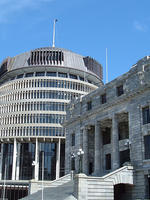
Government Reform: The New Zealand Example (Part 2)

At the World Bank’s series of forums on performance management, I found John Whitehead’s insights particularly interesting. Whitehead is a former secretary of the Treasury in New Zealand, which has been touted as the most advanced in performance-oriented government reform. He looked back on what worked and what did not in their reform efforts over the past 25 years. New Zealand’s efforts centering around four key elements:
- Instituting the elements of performance management (strategic planning, performance measurement, performance reporting, performance pay).
- Providing greater transparency in financial reporting, budgeting, and spending controls.
- Separating regulatory vs. service delivery roles.
- Separating commercial vs. non-commercial services provided by government.
In looking back over the past 25 years, governmental systems improved overall but there were some limitations to the New Zealand approach:
- Managers had more discretion to manage, but their focus on their performance contracts led them to lose sight of the bigger picture
- There was better staff retention, but greater internal competition for talent
- There was improved accountability, better fiscal and debt performance
- There were more silos and weaker collective action, leading to weak customer focus
- There were poor incentives to innovate and capture economies of scale; agencies were slower to adopt new technologies.
Based on what was learned, Whitehead sees the following next steps in New Zealand’s “performance journey:”
- Create a performance improvement framework with joint reviews (like the UK model) and focus on key governmental priorities.
- Institute biennial citizen surveys on governmental performance.
- Create an investment statement of the government – not just financial statements but performance statements, including how agencies plan to manage risk across their portfolios. Create a “results to citizens” report.
- Create a better public services initiative – improve government interactions with citizens and businesses (e.g.., a single business-facing agency, single natural resources agency)
- Encourage more cross-agency sharing of support services via the central agencies
- Move to 4-year budget plans with incentives to collaborate across agencies; consolidate appropriations.
- Increase use of public-private partnerships, joint ventures, “policy hubs.”
Other posts in the series on Government Reform:
Part 1: Government Reform: An International Snapshot of Progress on Performance Management
Part 2: The New Zealand Example
Part 3: Columbia and South Africa
Part 4: Kenya and Malaysia



